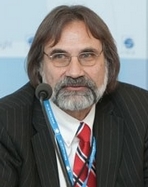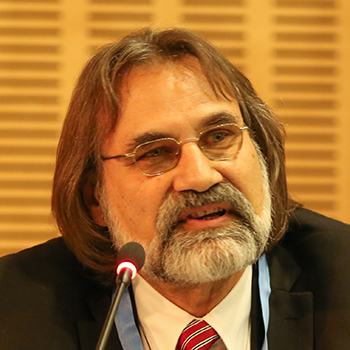 The greatest challenge for humanity is to achieve economic and social development while remaining within the safe operating space for a stable planet. To achieve this, rapid and equitable deployment of decarbonization technologies and systems are needed at all scales to improve energy efficiencies and to decrease emissions. This will require significant investments and research and development.
The greatest challenge for humanity is to achieve economic and social development while remaining within the safe operating space for a stable planet. To achieve this, rapid and equitable deployment of decarbonization technologies and systems are needed at all scales to improve energy efficiencies and to decrease emissions. This will require significant investments and research and development.
Emissions of greenhouse gases (GHG) and other pollutants such as black carbon, mainly from the production and use of fossil fuel-based energy, are rising, despite efforts by many countries to curb them. To achieve stabilization of climate at 2°C above preindustrial levels, global GHG emissions need to be halved by mid-century and reduced to zero before the century’s end.
At the same time, the demand for energy is growing. Without major transformational changes in the way we source and use energy, there is likely to be a 50 percent rise in energy needs in 2030 over 2010 levels. The energy transformation is key to resolving the pressing environmental challenges of anthropogenic climate change and many other global development issues. The energy transformation is about doing more with less. It is not only about “kilowatts.” It is also about “negawatts”
In September 2015 the United Nations General Assembly will adopt the Sustainable Development Goals (SDGs). The urgent need for an energy transformation is spelled out specifically in SDG7 on energy, which is highly relevant in a world where nearly 3 billion people have no access to clean modern energy services. For example, the practice of cooking with solid fuels results in indoor air pollution, which is responsible for some 4 million premature deaths every year, mostly among women and children. The energy transformation will catalyze the achievement of other SDGs, for example, SDG 13 on climate change. Or the goals on health, economic growth, gender equality, reducing inequality and sustainable consumption.
The energy transformation, as defined by the SDG7 on energy, by 2030 has three major objectives: i) universal access to sustainable energy for all; ii) doubling energy efficiency improvement rate; and iii) doubling the share of renewables in final energy. Objective i) can be achieved through sustained investments of the order of $40-60 billion per year, with additional measures and policies to enhance energy productivity. Aims ii) and iii) involve decarbonizing the energy system and drastically reducing GHG emissions, which would require a doubling of current global energy investments to some $1.3 billion per year.
SDG7 itself is rooted in the Sustainable Energy for All (SE4ALL) initiative of the United Nations Secretary-General. This, in turn, was based on the scientific evidence provided by the Global Energy Assessment (GEA; www.GlobalEnergyAssessment.org) a 5-year initiative led and coordinated by the International Institute for Applied Systems Analysis (IIASA: www.iiasa.ac.at). Published in 2013, the GEA was researched and written by 500 of the world’s leading energy experts and to date is the most authorative energy study ever undertaken. GEA provides regional perspectives both on specifics of the energy transformation as well as on required policy framework. For many years, a major focus of energy and climate science at IIASA has been to understand the actions needed to transform the world’s energy system and to advise policymakers accordingly.
The Balkan region, in common with the whole of southeastern Europe and other economies in transition, faces energy challenges that are hampering the energy transformation and hence sustainable development itself. Low-cost coal dominates energy supply, leading to severe emission levels and unfavorable market conditions for decarbonization. The regional potential for renewable energy sources remains unharnessed except for hydroelectric power and biomass use mainly for household heating. Energy efficiency improvements, usually the largest energy “source,” are also lagging.
Countries worldwide face similar challenges in transforming their energy systems to provide affordable, modern, sustainable energy services to all their citizens. The “energy gap” between those with and without access to clean energy is growing. If we are to improve human health, enhance economic development, and achieve environmental sustainability, closing the energy gap and breaking the cycle of systemic poverty and pollution is a human and environmental imperative
Thus in 2015 there is a unique opportunity for the nations of the world to agree a comprehensive and universal global agenda for sustainable development, thereby endorsing at the highest level the energy transformation already under way.
There will be different transformational pathways at different scales (sectors, nations, communities). The transformational pathways will intersect in places and interact. Tackling energy challenges will also have consequences for achieving energy-related SDGs like climate change. These interactions will produce co-benefits but they will also necessitate trade-offs. Recent integrated assessments at IIASA have found that by addressing energy access, air pollution and climate change mitigation simultaneously, the costs of achieving each separately could be almost halved.
Downscaling of the global analysis will also be crucial to vet development pathways on a regional scale: what do sustainable development pathways look like for southeastern Europe or the Balkans? What trade-offs can be expected and which are acceptable? And of course, what policy action can and needs to be taken on a regional or even national level to achieve the SDGs? Expert scientific opinion on these interactions will be required to provide information for policy and investment decisions.
Scientifically substantiated assessments, like GEA on energy and Intergovernmental Panel on Climate Change (IPCC), of the implications of the necessary transformative sustainable development pathways and the possible “degrees of freedom” in meeting the goals should perused in the coming months and years by a broad coalition of experts and stakeholders.
The integrated assessment work carried out by IIASA and its global partners can provide essential insights and innovative solutions as the world strives to attain the new SDGs and climate agreement in Paris end of 2015.
Nebojša Nakićenović,
Deputy Director General and Deputy Chief Executive Officer of the International Institute for Applied Systems Analysis (IIASA). Professor Emeritus of Energy Economics at the Vienna University of Technology.

 Author:
Author:





